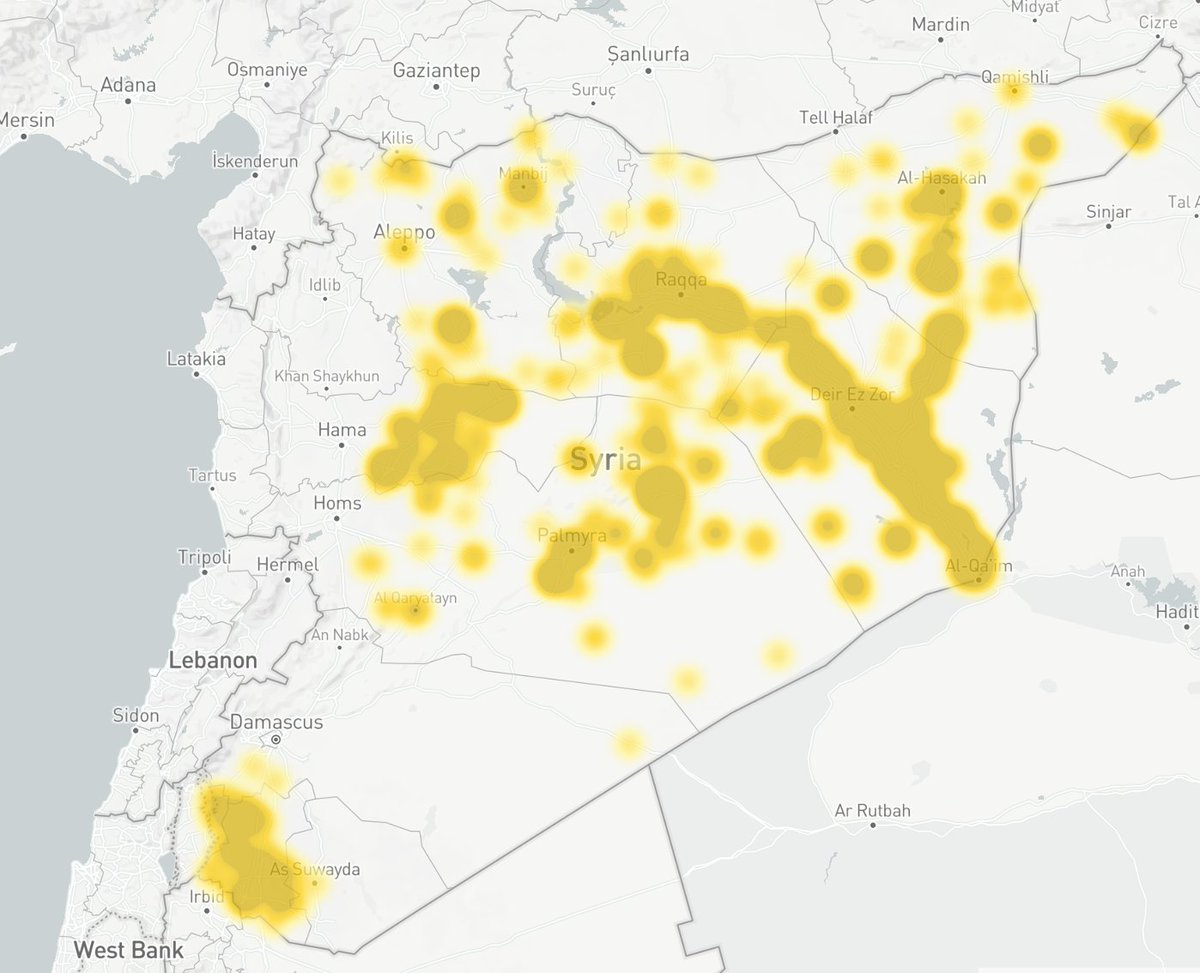1. Time for a status update on #IS.
We’ve been collecting and analysing #IS comms and chatter continuously for the last few years.
This is what the short- (50-day) and long-term (200-day) rolling averages look like for #IS attacks as of 10 October 2022.

We’ve been collecting and analysing #IS comms and chatter continuously for the last few years.
This is what the short- (50-day) and long-term (200-day) rolling averages look like for #IS attacks as of 10 October 2022.


2. In #Syria, after a three-fold decline across 2020/21, #IS’s reported activities have been hovering at roughly the same level since last summer.
Note that there was a fleeting surge after the #Ghwayran prison-break, but nothing sustained.
See tweet #12 for caveat.

Note that there was a fleeting surge after the #Ghwayran prison-break, but nothing sustained.
See tweet #12 for caveat.


3. In #Iraq, #IS’s network is seemingly in a similar place.
These days, less than half as many attacks are being reported on average compared with this time in 2020 and 2021.
See tweet #12 for caveat.

These days, less than half as many attacks are being reported on average compared with this time in 2020 and 2021.
See tweet #12 for caveat.


4. In #Afghanistan, #ISKP reporting is the lowest it’s been since Jan 2021 (when #ISKP was still mid-recovery after the 2019 rout).
This is partly a reflection of reality (#ISKP really is less active than it used to be) but also of disinformation (#ISKP under-/mis-reporting).

This is partly a reflection of reality (#ISKP really is less active than it used to be) but also of disinformation (#ISKP under-/mis-reporting).


5. In #Nigeria, by contrast, #ISWAP is significantly more active than it was in 2019, with a demonstrated ability to rapidly and at will expand operations.
Not only that, its sphere of influence has expanded across #Nigeria. No longer is it confined to the Lake Chad Basin.

Not only that, its sphere of influence has expanded across #Nigeria. No longer is it confined to the Lake Chad Basin.


6. As for the #DRC, there, #ISCAP/#ADF activities have also been on the rise, with two protracted surges earlier this year.
Note that there was a small burst of additional activity after the #Butembo prison break, but - so far - nothing sustained (just like in #Syria).

Note that there was a small burst of additional activity after the #Butembo prison break, but - so far - nothing sustained (just like in #Syria).


7. Over in #Mozambique, #IS’s local affiliate is lashing out more than ever, though it is territorially weaker than it was in 2020 and 2021.
In any case, it is clear that this network is now far more firmly in the orbit of #IS’s core administration.

In any case, it is clear that this network is now far more firmly in the orbit of #IS’s core administration.


8. On the official comms side, #IS’s Media Diwan has a new rest rate of five to ten photo-reports and one (max) video each week.
This is a far cry from the Media Diwan of 2015, which typically published 20-25 videos and around 175 photo-reports each week back then.

This is a far cry from the Media Diwan of 2015, which typically published 20-25 videos and around 175 photo-reports each week back then.


9. As for #IS’s munasirin, they are marginally less active than they were in 2021.
Interestingly, besides the #Ghwayran surge, the other two peaks in 2022 have come just *before* #IS published new leadership statements (dates indicated below).
Make of that what you will.
Interestingly, besides the #Ghwayran surge, the other two peaks in 2022 have come just *before* #IS published new leadership statements (dates indicated below).
Make of that what you will.

10. In terms of platform preference, #IS munasirin still overwhelmingly favour Telegram, though there was a short-lived experiment with WhatsApp between April and June 2022 (see left).
Compare that with #AQ's more sustained usage of WhatsApp across the same period (see right).

Compare that with #AQ's more sustained usage of WhatsApp across the same period (see right).


11. For more context on the above:
Syria: ctc.westpoint.edu/a-prison-attac…
Iraq: ctc.westpoint.edu/the-islamic-st…
Afghanistan: hudson.org/research/17796…
Nigeria: hudson.org/research/17872…
DRC: extremism.gwu.edu/islamic-state-…
Mozambique: public-assets.extrac.io/reports/ExTrac…
Comms: stratcomcoe.org/cuploads/pfile…
Syria: ctc.westpoint.edu/a-prison-attac…
Iraq: ctc.westpoint.edu/the-islamic-st…
Afghanistan: hudson.org/research/17796…
Nigeria: hudson.org/research/17872…
DRC: extremism.gwu.edu/islamic-state-…
Mozambique: public-assets.extrac.io/reports/ExTrac…
Comms: stratcomcoe.org/cuploads/pfile…
12. Important caveat: We know #IS has a tendency to deliberately withhold claims, so these data should only be understood as indicative.
For more on this under-reporting dynamic, see this analysis by @charliewinter and @gregorypwaters:
mei.edu/sites/default/…
For more on this under-reporting dynamic, see this analysis by @charliewinter and @gregorypwaters:
mei.edu/sites/default/…
13. For more information about our work, contact info@extrac.io or visit extrac.io.
• • •
Missing some Tweet in this thread? You can try to
force a refresh





























